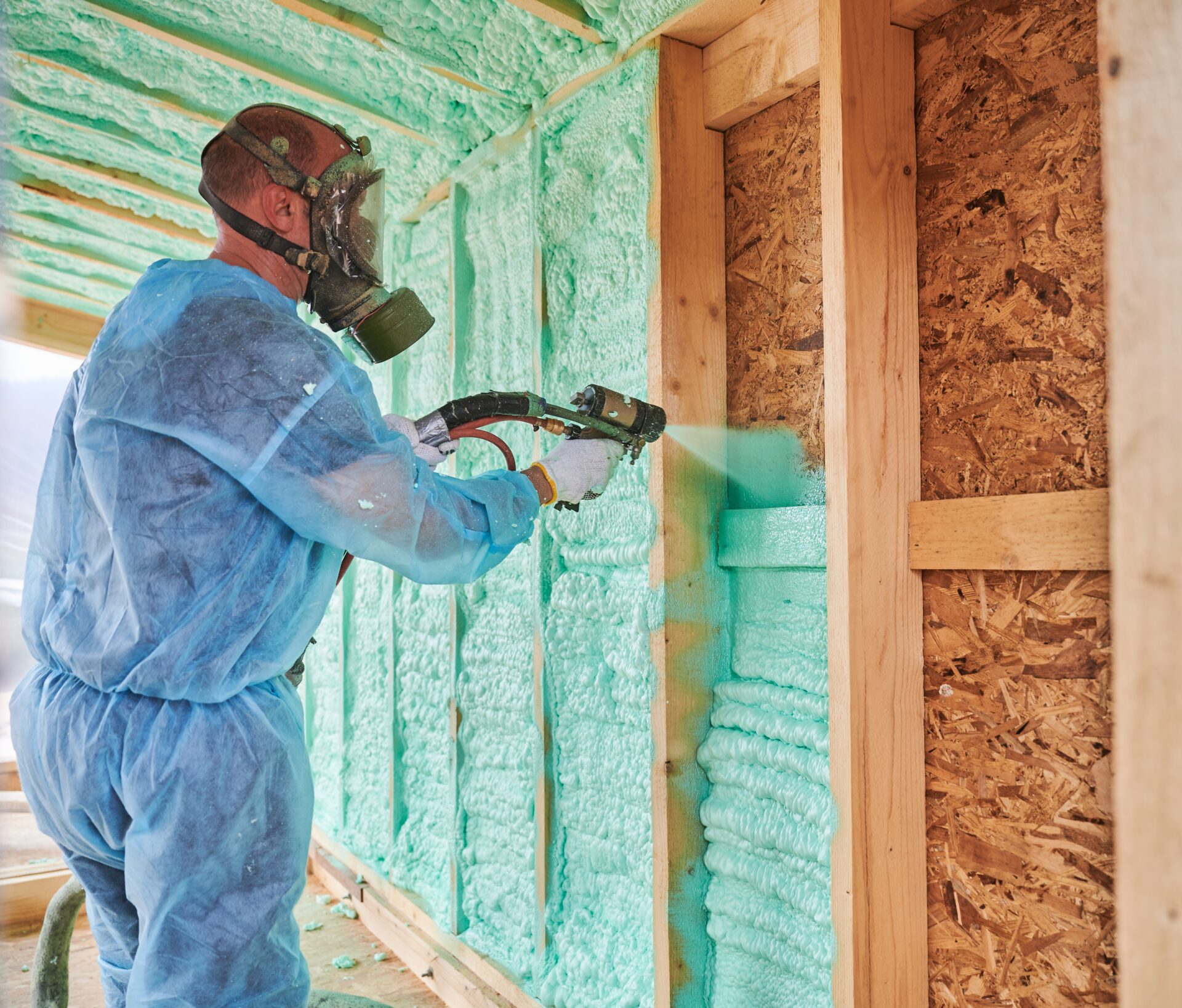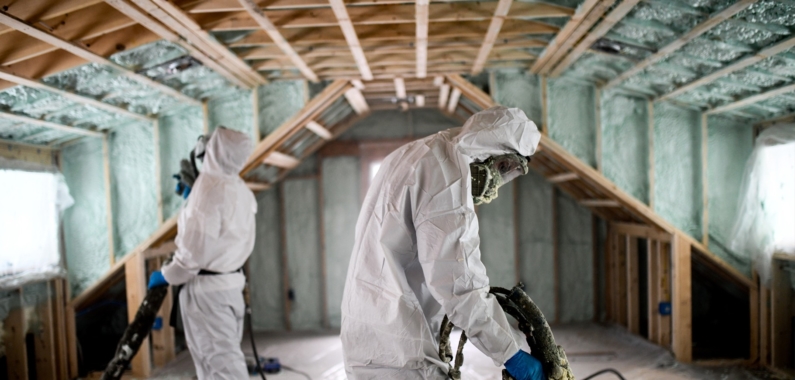Spray Foam: The Ultimate Option for Air Sealing and Insulation
Spray foam insulation has emerged as a leading remedy for reliable air securing and thermal insulation, supplying an one-of-a-kind mix of properties that set it apart from typical approaches. Comprehending the complete range of its benefits, installation procedures, and comparisons with other insulation kinds is critical for making informed choices.
What Is Spray Foam?
Spray foam is a flexible insulation material that incorporates the concepts of air sealing and thermal resistance to boost power effectiveness in buildings. Made up mostly of polyurethane or other comparable substances, spray foam is applied as a fluid that broadens upon contact with surfaces, producing a strong, continual layer of insulation. This special home allows it to load spaces, cracks, and gaps that standard insulation materials might neglect, giving a premium air seal.
There are two major kinds of spray foam: open-cell and closed-cell. Open-cell spray foam is lighter and extra versatile, offering exceptional sound absorption and a reduced R-value per inch - Spray Foam. On the other hand, closed-cell spray foam is denser, offering a greater R-value, moisture resistance, and included architectural stability to constructing components
The application process typically includes customized devices, making certain a seamless application that complies with various substrates, including metal, concrete, and timber. This flexibility makes spray foam suitable for both brand-new buildings and retrofitting existing frameworks. Its ability to produce an impermeable obstacle considerably adds to decreasing power consumption and improving indoor air top quality, thereby making it a preferred option among house owners and building contractors alike.
Advantages of Spray Foam Insulation
One of the most significant benefits of spray foam insulation is its phenomenal ability to develop a continual air obstacle, which effectively minimizes energy loss. Unlike standard insulation materials, spray foam broadens to load fractures and spaces, guaranteeing that air leak is significantly decreased. This particular not just improves energy efficiency but also leads to decrease energy costs with time.
In addition, spray foam insulation supplies remarkable thermal resistance, adding to a much more secure interior atmosphere. Its high R-value per inch enables for efficient insulation in confined rooms, making it ideal for attic rooms, walls, and crawl rooms. The moisture-resistant properties of spray foam assistance protect against mold and mildew and mold development, promoting much healthier living conditions.
Another critical advantage of spray foam insulation is its sound-dampening high qualities (Spray Foam). It efficiently lowers sound transmission between areas, producing a quieter and more comfy home atmosphere. The durability of spray foam also sticks out, as it does not droop or clear up with time, preserving its performance throughout its life expectancy
How Spray Foam Functions
Understanding exactly how spray foam insulation functions is vital for valuing its efficiency in air securing and thermal resistance. Spray foam insulation includes 2 primary components: isocyanate and polyol material. When these elements are combined, they undergo a chemical response that creates the material to broaden swiftly, creating a thick foam that loads fractures, gaps, and tooth cavities.
As the foam increases, it sticks to surfaces, developing an impermeable seal that substantially lowers air infiltration. This characteristic makes spray foam insulation extremely efficient at preventing drafts and moisture penetration, which can cause power loss and damages over time. Additionally, the closed-cell variation of spray foam uses premium thermal resistance due to its rigid structure, successfully decreasing warmth transfer.
The one-of-a-kind residential properties of spray foam permit it to adjust to uneven over at this website surfaces, ensuring comprehensive coverage and a smooth obstacle. Therefore, spray foam insulation not just boosts power performance yet additionally adds to enhanced indoor air high quality by decreasing the build-up of irritants and contaminants. Inevitably, recognizing the technicians behind spray foam highlights its role as a premium choice for insulation and air sealing in both business and household applications.
Installment Refine Summary

Prior to installment, the link space needs to be appropriately cleaned up and prepped, making certain that surfaces are totally free from dust, wetness, and particles. This step is important due to the fact that contaminants can compromise bond and general efficiency. As soon as the location is prepared, the application includes blending the 2 components of the spray foam, which expands upon get in touch with and fills up spaces successfully.
Educated professionals should carry out the installment, making use of specialized equipment to ensure uniform insurance coverage and optimal thickness. Safety and security precautions, consisting of putting on safety equipment and making sure appropriate air flow, are important during this process. After application, the foam typically cures quickly, creating a strong obstacle that improves energy effectiveness.
Comparing Spray Foam to Conventional Insulation
When assessing insulation options, spray foam insulation stands out in comparison to typical products such as fiberglass and cellulose. Among the primary advantages of spray foam is its superior air securing abilities. Unlike fiberglass and cellulose, which can allow air seepage, spray foam increases upon application, filling up gaps and gaps to create an impermeable seal. This leads to enhanced power effectiveness, as much less warmed or cooled air leaves the home, leading to reduced utility costs.
In addition, spray foam gives a greater R-value per inch than standard insulation types, using more reliable thermal resistance in a thinner profile. This particular is particularly advantageous in rooms with restricted dental caries deepness. Furthermore, spray foam is resistant to dampness and mold development, which can be a significant problem with cellulose and fiberglass, especially in humid atmospheres.
Nonetheless, spray foam insulation generally lugs a greater upfront expense than its typical counterparts. Homeowners need to consider this first investment against long-lasting power financial savings and efficiency benefits. you can look here Inevitably, while both insulation types serve their function, spray foam becomes an advanced solution for modern insulation needs, especially in terms of air sealing and thermal effectiveness.

Verdict
In recap, spray foam insulation stands for an extremely effective service for accomplishing optimal air sealing and thermal resistance. Its unique homes, including moisture resistance and audio dampening, make it ideal for numerous applications in both brand-new building and constructions and retrofitting tasks (Spray Foam). Although the first expenses may be higher contrasted to standard insulation materials, the long-term advantages, such as significant power financial savings and enhanced indoor air top quality, validate the investment and underscore its worth in contemporary structure methods.
Spray foam insulation has emerged as a leading option for efficient air sealing and thermal insulation, offering a special mix of residential properties that set it apart from typical techniques.Spray foam is a functional insulation product that incorporates the principles of air securing and thermal resistance to boost energy performance in buildings.When reviewing insulation choices, spray foam insulation stands out in contrast to conventional products such as fiberglass and cellulose. Ultimately, while both insulation kinds serve their purpose, spray foam emerges as an extra advanced option for modern-day insulation needs, specifically in terms of air sealing and thermal effectiveness.
In recap, spray foam insulation represents a highly effective option for achieving ideal air sealing and thermal resistance.